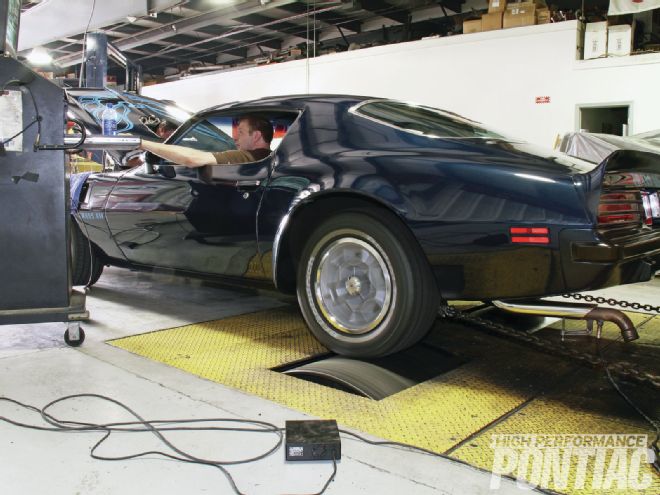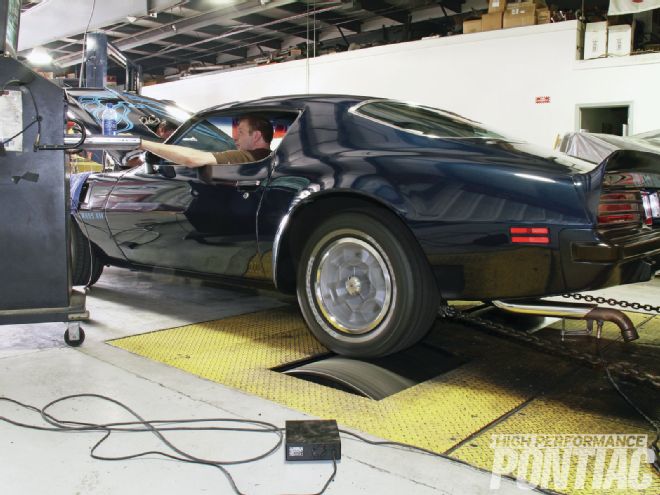
When trying to decide between two camshafts for an engine that will spend a majority of its life operating at low-to-moderate rpm on the street, it’s better to err on the side of caution. That means opting for the one with specs that are slightly tamer.

“What if it compromises full throttle performance?” you might ask. Well, you’ll probably be much more willing to spend an afternoon swapping rocker arms than spending a weekend installing a new camshaft just to find out!
A camshaft swap is rather involved. It includes partially disassembling an otherwise good-running engine to replace the cam, and if it’s a flat-tappet, there’s always the risk of lobe and/or lifter failure. To simulate the effects of a slightly larger camshaft, installing a set of high-ratio rocker arms is relatively easy and sometimes enough to noticeably improve performance.
Just how much of a difference is possible? We used our ’74 Super-Duty Trans Am to illustrate the effects. Here’s what we found.
Most Pontiac camshafts contained a maximum lobe lift of 0.271 inch, and the Division’s typical stamped-steel rocker arm featured an opening ratio of 1.5:1. Simply multiplying lobe lift by rocker-arm ratio will yield gross valve lift for a given camshaft. In the instance of many four-barrel and Tri-Power–equipped Pontiacs, it equates to roughly 0.407-inch valve lift—an amount that most Pontiac hobbyists are familiar with when speaking of stock grinds.
Considering that the intake airflow of a typical cast-iron D-port cylinder head peaks around 210 cfm at 28 inches of pressure, and it does so by about 0.450-inch valve lift, the near 0.400-inch valve lift that Pontiac engineers chose was close to the head’s potential. When selecting an aftermarket camshaft for an engine that uses unmodified D-port heads, it makes little sense to push valve lift much beyond 0.450 inch or so.
Most modern high-performance engine rebuilds include high-flow aftermarket cast-aluminum cylinder heads or modified cast-iron originals. And many aftermarket camshafts offer a reasonable amount of valve lift to accommodate the increased airflow capacity. When Pontiac needed more valve lift to take advantage of the new round-port cylinder heads it developed for the ’69-’70 R/A-IV, a stamped-steel rocker arm with a 1.65:1 ratio was employed, effectively increasing valve lift from the No. 041 to nearly 0.520 inch.
According to the late Mac McKellar, the famed engineer responsible for developing a number of Pontiac’s cutting-edge cam designs—including the No. 041—increasing rocker-arm ratio is an easy and effective way to increase gross valve lift from any camshaft. It’s less stressful on the block since the lifter doesn’t have to travel quite as far in the lifter bore, and it reduces the side loading that occurs when running an aggressive flat-tappet grind.
Rocker-arm ratio is determined by the pushrod cup’s position in relation to the fulcrum (or rocker stud). Moving the cup closer to the rocker stud increases ratio, but it also changes the pushrod’s path angle during normal operation. Most often, the drilled pushrod opening in a typical Pontiac cylinder head must be relieved using a grinder to prevent rubbing when using rocker arms with a ratio greater than about 1.6:1. And that’s a task that must be performed with the cylinder heads removed from the engine, and preferably completely disassembled.
There may be instances where the pushrods do not contact the drilled opening when using high-ratio rockers. That doesn’t suggest swapping rocker arms on any engine, however. It’s very important to know the condition and coil-bind limit of the valvesprings being used. (That’s not just limited to high-ratio rocker arms—it includes camshaft swaps, too.) It’s also wise to replace the original 3⁄8-inch bottleneck studs with quality 7⁄16-inch units. Not only does it allow for infinite valve-lash adjustment, bottleneck studs can and do break when valve lift exceeds about 0.450 inch or so.
Increasing rocker-arm ratio not only increases valve lift, it also alters the rate at which the valve opens and closes. As the lifter tracks the camshaft lobe, it transfers motion to the valve through the rocker arm. A high-ratio rocker arm increases valve lift at every point. It boosts gross valve lift by several hundredths of an inch, but it can make a camshaft seem a few degrees larger as well. And if the engine can tolerate slightly more camshaft duration and/or the cylinder heads can support additional valve lift, a performance increase usually results.
To illustrate the effects that a high-ratio rocker-arm swap can have on a vehicle, we purchased and installed a set of 1.65:1-ratio rockers on our ’74 Trans Am. Its Super-Duty 455 is arguably the most under-cammed performance engine that Pontiac ever produced. Throughout development it used a No. 041-spec camshaft with 0.470-inch valve lift, but when it reached production in mid-year 1973, the high-lift cam gave way a tamer No. 744-spec grind, which included 0.407-inch valve lift. While it improved emissions compliancy, the cam change noticeably reduced peak horsepower from 310 to 290. The 1.65:1-ratio rocker arms increases valve lift by 10 percent toward 0.450 inch, allowing our SD-455 to breath a bit deeper.
Before any modifications, we established a baseline using the Mustang Dyno at C&S Dyno Shop in Omaha, Nebraska. A series of pulls were made between 2,500 and 5,200 rpm. We tried several secondary metering rod and timing combinations, and the best was 260 hp at 4,500 rpm and 331 lb-ft at 3,700 rpm at the rear tires. After factoring a 25 percent driveline loss, we estimate that our SD-455 is generating about 325 hp and 410 lb-ft at the crank—a remarkable amount from an unmodified smog-era engine with low compression.
Though we could have purchased aftermarket high-ratio roller-rocker arms from any Pontiac vendor or mail-order supplier, maintaining originality and ease of install was a concern. We ultimately decided upon a set of OE- replacement, 1.65:1, stamped-steel rocker arms from Melling. Our reasoning is they fit and function like the originals, will clear the stock valve covers, and operate quietly and consistently—all important factors to us. And if we aren’t satisfied with the result, we can easily reinstall the original 1.5:1 rockers at any time.
Installation was straightforward. We focused on one cylinder bank at a time, and addressed each pair of intake and exhaust rocker arms individually. We made sure that the lifters were on the base lobe before removing the original 1.5:1 rocker arms and 3⁄8-inch bottleneck rocker studs, and had the 7⁄16-inch ARP rocker studs and Melling 1.65:1 rockers installed in a couple of hours.
During installation, we used the pushrod-drag method to set valve lash to a half-turn past zero. An alternative method is to start the engine with the valve cover off, loosen a rocker nut until the rocker begins to clack, and then slowly tighten the nut until the sound immediately goes away. Once at zero lash, the rocker nut can then be tightened to the desired amount of preload.
Either method accomplishes the same goal, but some consider the latter a bit more accurate, particularly when replacing rocker arms only.
Upon initial startup, we immediately noticed that SD-455’s exhaust note was choppier than before. The initial test drive proved no detectible loss of low speed street manners, and the adjustable valvetrain seemed to have a positive effect on engine operation at part-throttle cruise, as it seemed smoother. We were convinced after a full-throttle blast that the SD-455 pulled a bit harder up top. Was our seat-of-the-pants testing correct? A follow-up session on the chassis dyno would tell the tale.
On the Mustang Dyno at C&S Dyno Shop shortly after the install, it was clear that the SD-455 was generating more power than before after just one pull. Subsequent pulls included various secondary metering rods, and in the end, the Super-Duty peaked at 271 rwhp and 334 lb-ft of rear wheel torque. Not surprisingly, both peaks were a few hundred rpm higher than before, indicating this particular engine recognized the effective duration from the camshaft was slightly larger.
Not every hobbyist owns an SD-455 or uses a low-lift, OE-spec camshaft in their Pontiac V-8. We chose this particular vehicle to illustrate the effects of our test since it was clearly lift deficient from the factory and would show a noticeable performance increase on the dyno—and it didn’t disappoint.
An increase of 11 rwhp is a reasonable amount for the effort involved, and similar results are possible from many engines, but not every combination will show a performance increase. Depending upon the camshaft chosen during your rebuild and the airflow capacity of your particular cylinder heads, your engine may not show any gain with high-ratio rockers. In fact, if your Pontiac is already equipped with high-ratio rockers and its camshaft seems a bit ragged, you might consider trying a set of low-ratio rockers to tame it slightly, or even different-ratio rockers on the intake and exhaust.
In the end, it’s a trial and error approach to find the rocker-arm combination that best suits your engine, but it’s definitely worth the effort if maximizing your Pontiac’s performance is important to you.